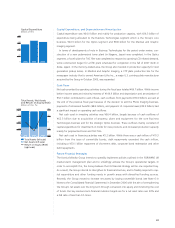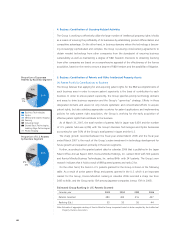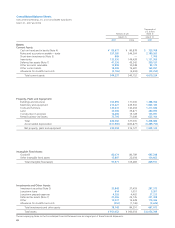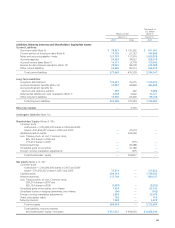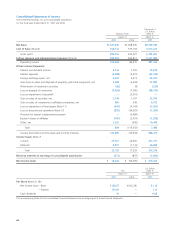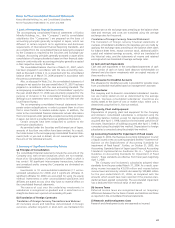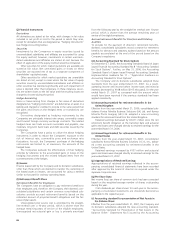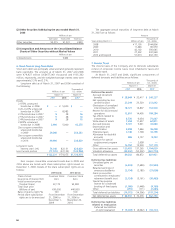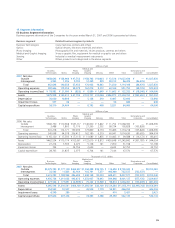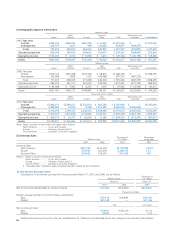Konica Minolta 2007 Annual Report Download - page 49
Download and view the complete annual report
Please find page 49 of the 2007 Konica Minolta annual report below. You can navigate through the pages in the report by either clicking on the pages listed below, or by using the keyword search tool below to find specific information within the annual report.47
Notes to The Consolidated Financial Statements
Konica Minolta Holdings, Inc. and Consolidated Subsidiaries
For the fiscal years ended March 31, 2007 and 2006
1. Basis of Presenting Financial Statements
The accompanying consolidated financial statements of Konica
Minolta Holdings, Inc., (the “Company”) and its consolidated
subsidiaries (the “Companies”) are prepared on the basis of
accounting principles generally accepted in Japan, which are
different in certain respects as to application and disclosure
requirements of International Financial Reporting Standards, and
are compiled from the consolidated financial statements prepared
by the Company as required by the Securities and Exchange Law
of Japan. Accounting principles generally accepted in Japan allow
consolidation of foreign subsidiaries based on their financial state-
ments in conformity with accounting principles generally accepted
in their respective country of domicile.
The consolidated balance sheet as of March 31, 2007, which
has been prepared in accordance with the new accounting stan-
dard as discussed in Note 2 (r), is presented with the consolidated
balance sheet as of March 31, 2006 prepared in accordance with
the previous presentation rules.
Also, as discussed in Note 2 (s), the consolidated statement of
changes in net assets for the year ended March 31, 2007 has been
prepared in accordance with the new accounting standard. The
accompanying consolidated statement of shareholders’ equity for
the year ended March 31, 2006 was voluntarily prepared for the
purpose of inclusion in the consolidated financial statements
although such statements were not required to be filed with the
Local Finance Bureau.
The accompanying consolidated financial statements incor-
porate certain reclassifications in order to present them in a form
that is more familiar to readers outside Japan. In addition, the
notes to the consolidated financial statements include information
that is not required under generally accepted accounting principles
in Japan, but which is provided herein as additional information.
Certain amounts have been reclassified to conform to the
current year classifications.
As permitted under the Securities and Exchange Law of Japan,
amounts of less than one million have been omitted. As a result,
the totals shown in the accompanying consolidated financial state-
ments (both in yen and in dollars) do not necessarily agree with
the sums of the individual amounts.
2. Summary of Significant Accounting Policies
(a) Principles of Consolidation
The consolidated financial statements include the accounts of the
Company and, with certain exceptions which are not material,
those of its 120 subsidiaries (124 subsidiaries for 2006) in which it
has control. All significant intercompany transactions, balances
and unrealized profits among the Companies are eliminated on
consolidation.
Investments in 10 unconsolidated subsidiaries (11 uncon-
solidated subsidiaries for 2006) and 3 significant affiliates (3
significant affiliates for 2006) are accounted for using the equity
method. Investments in other unconsolidated subsidiaries and
affiliates are stated at cost, since they have no material effect on
the consolidated financial statements.
The excess of cost over the underlying investments in
subsidiaries is recognized as goodwill and is amortized on a
straight-line basis over a period not exceeding 20 years.
(b) Translation of Foreign Currencies
Translation of Foreign Currency Transactions and Balances
All monetary assets and liabilities denominated in foreign
currencies, whether long-term or short-term, are translated into
Japanese yen at the exchange rates prevailing at the balance sheet
date and revenues and costs are translated using the average
exchange rates for the period.
Translation of Foreign Currency Financial Statements
The translation of foreign currency financial statements of
overseas consolidated subsidiaries into Japanese yen are made by
applying the exchange rates prevailing at the balance sheet dates
for balance sheet items, except common stock, additional paid-in
capital and retained earnings accounts, which are translated at
the historical rates, and the statements of income and retained
earnings which are translated at average exchange rates.
(c) Cash and Cash Equivalents
Cash and cash equivalents in the consolidated statements of cash
flows consist of cash on hand, bank deposits withdrawable on
demand and short-term investments with an original maturity of
three months or less.
(d) Allowance for Doubtful Accounts
The allowance for doubtful accounts is provided for possible losses
from uncollectible receivables based on management’s estimate.
(e) Inventories
The company and its domestic consolidated subsidiaries’ invento-
ries are mainly stated at cost as determined by the average
method. Overseas consolidated subsidiaries’ inventories are
mainly stated at the lower of cost or market value, where cost is
determined using the first-in, first-out method.
(f) Property, Plant and Equipment
Depreciation of property, plant and equipment for the Company
and domestic consolidated subsidiaries is computed using the
declining balance method, except for depreciation of buildings
acquired after April 1, 1998, based on the estimated useful lives of
the assets. Depreciation of buildings acquired after April 1, 1998 is
computed using the straight-line method. Depreciation for foreign
subsidiaries is computed using the straight-line method.
(g) Accounting Standard for Impairment of Fixed Assets
On August 9, 2002, the Business Accounting Deliberation Council
of Japan issued a new accounting standard entitled “Statement of
Opinion on the Establishment of Accounting Standards for
Impairment of Fixed Assets”. Further, on October 31, 2003, the
Accounting Standards Board of Japan issued Financial Accounting
Standards Implementation Guidance No. 6 – “Application
Guidance on Accounting Standards for Impairment of Fixed
Assets”. These standards are effective from fiscal years beginning
April 1, 2005.
The Company and its domestic subsidiaries adopted these
standards from the year ended March 31, 2006. As a result, oper-
ating income increased by ¥3,018 million and income before
income taxes and minority interests decreased by ¥29,483 million
for the year ended March 31, 2006, as compared with the
amounts which would have been reported if the previous stan-
dards had been applied consistently. The accumulated impairment
loss is deducted from net book value of each asset.
(h) Income Taxes
Deferred income taxes are recognized based on temporary
differences between the tax basis of assets and liabilities and those
as reported in the consolidated financial statements.
(i) Research and Development Costs
Research and development costs are expensed as incurred.


